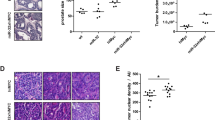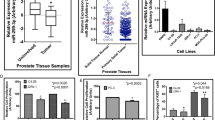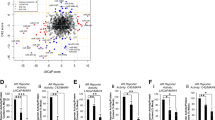Abstract
Src tyrosine kinase (Src) is implicated in the development of bone metastasis and castration resistance of prostate cancer. Src inhibitors are currently being tested in clinical trials for such diseases. Understanding the molecular and cellular actions of Src inhibitors holds the key to future improvement of this line of therapy. Here we describe the microRNA expression profiles modulated by two Src inhibitors and demonstrate that the miR-30 family members are the most prominently induced species. Consistent with its tumor suppressor role, miR-30 is downmodulated by oncogenic signals such as epidermal growth factor (EGF) and hepatocyte growth factor, and is generally underexpressed in prostate cancer specimens. A number of epithelial-to-mesenchymal transition (EMT)-associated genes are predicted targets of miR-30. Among these genes the Ets-related gene (ERG) is the most frequently overexpressed oncogene in prostate cancer activated by genomic fusion events between promoter upstream sequences of the TMPRSS2 and coding sequences of ERG. We showed by ERG 3′ untranslated region reporter and mutagenesis assays that ERG is a direct target of miR-30. Overexpression of miR-30 in prostate cancer cells suppresses EMT phenotypes and inhibits cell migration and invasion. It also inhibits the in vitro and in vivo growth of VCaP cells, which depends on TMPRSS2-ERG for proliferation. TMPRSS2-ERG is generally regulated by androgen at the transcriptional level. Our finding reveals a new post-transcriptional mechanism of TMPRSS2-ERG regulation by Src and growth signals via miR-30 providing a rationale for targeting ERG-positive castration-resistant tumors with Src inhibitors.
This is a preview of subscription content, access via your institution
Access options
Subscribe to this journal
Receive 50 print issues and online access
$259.00 per year
only $5.18 per issue
Buy this article
- Purchase on Springer Link
- Instant access to full article PDF
Prices may be subject to local taxes which are calculated during checkout






Similar content being viewed by others
References
Kung HJ . Targeting tyrosine kinases and autophagy in prostate cancer. Horm Cancer 2011; 2: 38–46.
Tatarov O, Mitchell TJ, Seywright M, Leung HY, Brunton VG, Edwards J . SRC family kinase activity is up-regulated in hormone-refractory prostate cancer. Clin Cancer Res 2009; 15: 3540–3549.
Cai H, Babic I, Wei X, Huang J, Witte ON . Invasive prostate carcinoma driven by c-Src and androgen receptor synergy. Cancer Res 2011; 71: 862–872.
Lee LF, Guan J, Qiu Y, Kung HJ . Neuropeptide-induced androgen independence in prostate cancer cells: roles of nonreceptor tyrosine kinases Etk/Bmx, Src, and focal adhesion kinase. Mol Cell Biol 2001; 21: 8385–8397.
Yang JC, Bai L, Yap S, Gao AC, Kung HJ, Evans CP . Effect of the specific Src family kinase inhibitor saracatinib on osteolytic lesions using the PC-3 bone model. Mol Cancer Ther 2010; 9: 1629–1637.
Araujo J, Logothetis C . Targeting Src signaling in metastatic bone disease. Int J Cancer 2009; 124: 1–6.
Desai SJ, Ma AH, Tepper CG, Chen HW, Kung HJ . Inappropriate activation of the androgen receptor by nonsteroids: involvement of the Src kinase pathway and its therapeutic implications. Cancer Res 2006; 66: 10449–10459.
Lee LF, Louie MC, Desai SJ, Yang J, Chen HW, Evans CP et al. Interleukin-8 confers androgen-independent growth and migration of LNCaP: differential effects of tyrosine kinases Src and FAK. Oncogene 2004; 23: 2197–2205.
Guo Z, Dai B, Jiang T, Xu K, Xie Y, Kim O et al. Regulation of androgen receptor activity by tyrosine phosphorylation. Cancer Cell 2006; 10: 309–319.
Kraus S, Gioeli D, Vomastek T, Gordon V, Weber MJ . Receptor for activated C kinase 1 (RACK1) and Src regulate the tyrosine phosphorylation and function of the androgen receptor. Cancer Res 2006; 66: 11047–11054.
Bello D, Webber MM, Kleinman HK, Wartinger DD, Rhim JS . Androgen responsive adult human prostatic epithelial cell lines immortalized by human papillomavirus 18. Carcinogenesis 1997; 18: 1215–1223.
Zhoul J, Hernandez G, Tu SW, Huang CL, Tseng CP, Hsieh JT . The role of DOC-2/DAB2 in modulating androgen receptor-mediated cell growth via the nongenomic c-Src-mediated pathway in normal prostatic epithelium and cancer. Cancer Res 2005; 65: 9906–9913.
Nam S, Kim D, Cheng JQ, Zhang S, Lee JH, Buettner R et al. Action of the Src family kinase inhibitor, dasatinib (BMS-354825), on human prostate cancer cells. Cancer Res 2005; 65: 9185–9189.
Chang YM, Bai L, Liu S, Yang JC, Kung HJ, Evans CP . Src family kinase oncogenic potential and pathways in prostate cancer as revealed by AZD0530. Oncogene 2008; 27: 6365–6375.
Wu Z, Chang PC, Yang JC, Chu CY, Wang LY, Chen NT et al. Autophagy blockade sensitizes prostate cancer cells towards Src family kinase inhibitors. Genes Cancer 2010; 1: 40–49.
Brunton VG, Frame MC . Src and focal adhesion kinase as therapeutic targets in cancer. Curr Opin Pharmacol 2008; 8: 427–432.
Yu EY, Wilding G, Posadas E, Gross M, Culine S, Massard C et al. Phase II study of dasatinib in patients with metastatic castration-resistant prostate cancer. Clin Cancer Res 2009; 15: 7421–7428.
Summy JM, Gallick GE . Treatment for advanced tumors: SRC reclaims center stage. Clin Cancer Res 2006; 12: 1398–1401.
Bowman T, Broome MA, Sinibaldi D, Wharton W, Pledger WJ, Sedivy JM et al. Stat3-mediated Myc expression is required for Src transformation and PDGF-induced mitogenesis. Proc Natl Acad Sci USA 2001; 98: 7319–7324.
Karni R, Gus Y, Dor Y, Meyuhas O, Levitzki A . Active Src elevates the expression of beta-catenin by enhancement of cap-dependent translation. Mol Cell Biol 2005; 25: 5031–5039.
Li X, Shen Y, Ichikawa H, Antes T, Goldberg GS . Regulation of miRNA expression by Src and contact normalization: effects on nonanchored cell growth and migration. Oncogene 2009; 28: 4272–4283.
Petrovics G, Liu A, Shaheduzzaman S, Furusato B, Sun C, Chen Y et al. Frequent overexpression of ETS-related gene-1 (ERG1) in prostate cancer transcriptome. Oncogene 2005; 24: 3847–3852.
Tomlins SA, Rhodes DR, Perner S, Dhanasekaran SM, Mehra R, Sun XW et al. Recurrent fusion of TMPRSS2 and ETS transcription factor genes in prostate cancer. Science 2005; 310: 644–648.
Wang J, Cai Y, Ren C, Ittmann M . Expression of variant TMPRSS2/ERG fusion messenger RNAs is associated with aggressive prostate cancer. Cancer Res 2006; 66: 8347–8351.
Klezovitch O, Risk M, Coleman I, Lucas JM, Null M, True LD et al. A causal role for ERG in neoplastic transformation of prostate epithelium. Proc Natl Acad Sci USA 2008; 105: 2105–2110.
Tomlins SA, Laxman B, Varambally S, Cao X, Yu J, Helgeson BE et al. Role of the TMPRSS2-ERG gene fusion in prostate cancer. Neoplasia 2008; 10: 177–188.
Zong Y, Xin L, Goldstein AS, Lawson DA, Teitell MA, Witte ON . ETS family transcription factors collaborate with alternative signaling pathways to induce carcinoma from adult murine prostate cells. Proc Natl Acad Sci USA 2009; 106: 12465–12470.
King JC, Xu J, Wongvipat J, Hieronymus H, Carver BS, Leung DH et al. Cooperativity of TMPRSS2-ERG with PI3-kinase pathway activation in prostate oncogenesis. Nat Genet 2009; 41: 524–526.
Wang J, Cai Y, Yu W, Ren C, Spencer DM, Ittmann M . Pleiotropic biological activities of alternatively spliced TMPRSS2/ERG fusion gene transcripts. Cancer Res 2008; 68: 8516–8524.
Sun C, Dobi A, Mohamed A, Li H, Thangapazham RL, Furusato B et al. TMPRSS2-ERG fusion, a common genomic alteration in prostate cancer activates C-MYC and abrogates prostate epithelial differentiation. Oncogene 2008; 27: 5348–5353.
Yu J, Mani RS, Cao Q, Brenner CJ, Cao X, Wang X et al. An integrated network of androgen receptor, polycomb, and TMPRSS2-ERG gene fusions in prostate cancer progression. Cancer Cell 2010; 17: 443–454.
Gupta S, Iljin K, Sara H, Mpindi JP, Mirtti T, Vainio P et al. FZD4 as a mediator of ERG oncogene-induced WNT signaling and epithelial-to-mesenchymal transition in human prostate cancer cells. Cancer Res 2010; 70: 6735–6745.
Leshem O, Madar S, Kogan-Sakin I, Kamer I, Goldstein I, Brosh R et al. TMPRSS2/ERG promotes epithelial to mesenchymal transition through the ZEB1/ZEB2 axis in a prostate cancer model. PLoS ONE 2011; 6: e21650.
Lin C, Yang L, Tanasa B, Hutt K, Ju BG, Ohgi K et al. Nuclear receptor-induced chromosomal proximity and DNA breaks underlie specific translocations in cancer. Cell 2009; 139: 1069–1083.
Mani RS, Tomlins SA, Callahan K, Ghosh A, Nyati MK, Varambally S et al. Induced chromosomal proximity and gene fusions in prostate cancer. Science 2009; 326: 1230.
Cai C, Wang H, Xu Y, Chen S, Balk SP . Reactivation of androgen receptor-regulated TMPRSS2:ERG gene expression in castration-resistant prostate cancer. Cancer Res 2009; 69: 6027–6032.
Volinia S, Galasso M, Costinean S, Tagliavini L, Gamberoni G, Drusco A et al. Reprogramming of miRNA networks in cancer and leukemia. Genome Res 2010; 20: 589–599.
Porkka KP, Pfeiffer MJ, Waltering KK, Vessella RL, Tammela TL, Visakorpi T . MicroRNA expression profiling in prostate cancer. Cancer Res 2007; 67: 6130–6135.
Van der Auwera I, Limame R, van Dam P, Vermeulen PB, Dirix LY, Van Laere SJ . Integrated miRNA and mRNA expression profiling of the inflammatory breast cancer subtype. Br J Cancer 2010; 103: 532–541.
Liu C, Kelnar K, Vlassov AV, Brown D, Wang J, Tang DG . Distinct microRNA expression profiles in prostate cancer stem/progenitor cells and tumor-suppressive functions of let-7. Cancer Res 2012; 72: 3393–3404.
Rothschild SI, Tschan MP, Federzoni EA, Jaggi R, Fey MF, Gugger M et al. MicroRNA-29b is involved in the Src-ID1 signaling pathway and is dysregulated in human lung adenocarcinoma. Oncogene 2012; 31: 4221–4232.
Garofalo M, Romano G, Di Leva G, Nuovo G, Jeon YJ, Ngankeu A et al. EGFR and MET receptor tyrosine kinase-altered microRNA expression induces tumorigenesis and gefitinib resistance in lung cancers. Nat Med 2012; 18: 74–82.
Hebbard L, Cecena G, Golas J, Sawada J, Ellies LG, Charbono A et al. Control of mammary tumor differentiation by SKI-606 (bosutinib). Oncogene 2011; 30: 301–312.
Martinez I, Cazalla D, Almstead LL, Steitz JA, DiMaio D . miR-29 and miR-30 regulate B-Myb expression during cellular senescence. Proc Natl Acad Sci USA 2011; 108: 522–527.
Yu F, Deng H, Yao H, Liu Q, Su F, Song E . Mir-30 reduction maintains self-renewal and inhibits apoptosis in breast tumor-initiating cells. Oncogene 2010; 29: 4194–4204.
Zhong X, Li N, Liang S, Huang Q, Coukos G, Zhang L . Identification of microRNAs regulating reprogramming factor LIN28 in embryonic stem cells and cancer cells. J Biol Chem 2010; 285: 41961–41971.
Braun J, Hoang-Vu C, Dralle H, Huttelmaier S . Downregulation of microRNAs directs the EMT and invasive potential of anaplastic thyroid carcinomas. Oncogene 2010; 29: 4237–4244.
Zhang J, Zhang H, Liu J, Tu X, Zang Y, Zhu J et al. miR-30 inhibits TGF-beta1-induced epithelial-to-mesenchymal transition in hepatocyte by targeting Snail1. Biochem Biophys Res Commun 2012; 417: 1100–1105.
Joglekar MV, Patil D, Joglekar VM, Rao GV, Reddy DN, Mitnala S et al. The miR-30 family microRNAs confer epithelial phenotype to human pancreatic cells. Islets 2009; 1: 137–147.
Hollenhorst PC, Paul L, Ferris MW, Graves BJ . The ETS gene ETV4 is required for anchorage-independent growth and a cell proliferation gene expression program in PC3 prostate cells. Genes Cancer 2011; 1: 1044–1052.
Quintavalle C, Donnarumma E, Iaboni M, Roscigno G, Garofalo M, Romano G et al. Effect of miR-21 and miR-30b/c on TRAIL-induced apoptosis in glioma cells. Oncogene 2013; 32: 4001–4008.
Schmittgen TD, Livak KJ . Analyzing real-time PCR data by the comparative C(T) method. Nat Protoc 2008; 3: 1101–1108.
Acknowledgements
This work was supported in part by NIH grants (CA150197 and CA165263) and DOD grant (PC093350) to HJK. CJK acknowledges the support of DOD postdoctoral fellowship (PC110744). We are grateful to M Bradnam for excellent editorial assistance of this manuscript.
Author information
Authors and Affiliations
Corresponding author
Ethics declarations
Competing interests
The authors declare no conflict of interest.
Additional information
Supplementary Information accompanies this paper on the Oncogene website
Rights and permissions
About this article
Cite this article
Kao, CJ., Martiniez, A., Shi, XB. et al. miR-30 as a tumor suppressor connects EGF/Src signal to ERG and EMT. Oncogene 33, 2495–2503 (2014). https://doi.org/10.1038/onc.2013.200
Received:
Revised:
Accepted:
Published:
Issue Date:
DOI: https://doi.org/10.1038/onc.2013.200
Keywords
This article is cited by
-
miR-3195 suppresses the malignant progression of osteosarcoma cells via targeting SOX4
Journal of Orthopaedic Surgery and Research (2023)
-
Menin inhibition suppresses castration-resistant prostate cancer and enhances chemosensitivity
Oncogene (2022)
-
Long noncoding RNA CAR10 promotes lung adenocarcinoma metastasis via miR-203/30/SNAI axis
Oncogene (2019)
-
Ethnicity and ERG frequency in prostate cancer
Nature Reviews Urology (2018)
-
Expression of microRNA Potentially Regulated by AhR and CAR in Malignant Tumors of the Endometrium
Bulletin of Experimental Biology and Medicine (2018)



